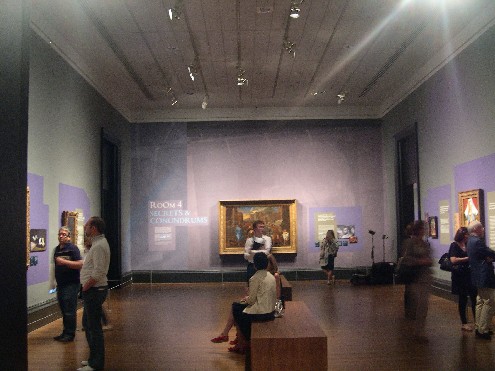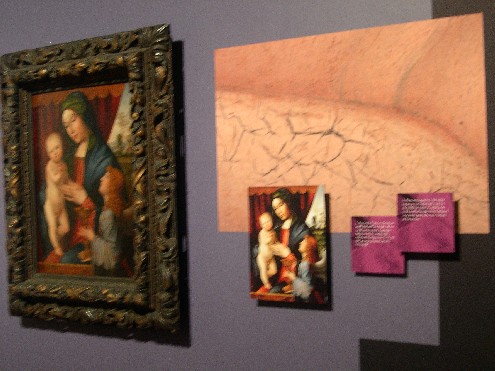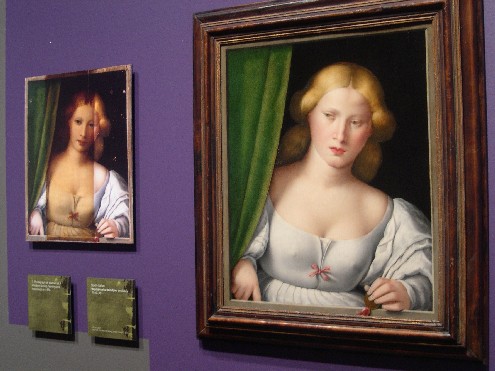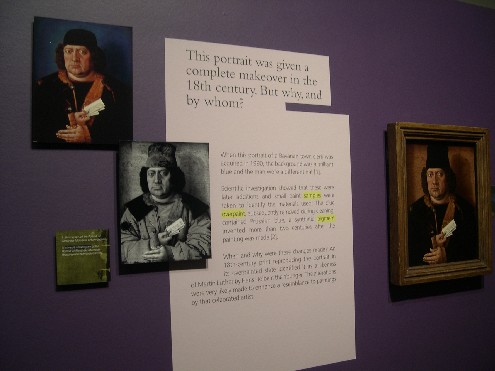
Showcasing fakes at the National Gallery in London
By Michael Banks
It might seem a strange idea to have an exhibition showcasing fake works of art as well as pieces that have been significantly modified over time. But that is all part of a new exhibition at London’s National Gallery looking at how science can help to restore art as well as spot fake art pieces.
Yesterday I attended the opening of the gallery’s new exhibition Close Examination: Fakes, Mistakes and Discoveries. The exhibition, which is free to enter, is open to the public starting today and runs until 12 September.
We were shown around the exhibition’s six rooms by Ashok Roy, the National Gallery’s director of science. Each room in the exhibition explains how science is used to establish the originality of art pieces. This could be by using X-ray or infrared radiation to discover hidden drawings beneath the layers of paint to Raman spectroscopy, which can be used to identify the make up of pigments that are used in the paint.
One of the first paintings Roy showed us was The Virgin and Child with an Angel – in the first room of the exhibition dubbed “deception and deceit” – that was created in the 15th century by the Italian painter Francesco Francia.

To give the appearance of ageing, cracks were drawn on the painting
The painting was given to the National Gallery in 1924 and thought to be an original. However, after another, smaller version of the same painting appeared at an art auction in 1954, art historians deduced that the work owned by the National Gallery was a copy.
Roy showed that the copy was actually quite elaborately done. Indeed, when researchers studied it using infrared radiation they saw a carefully drawn outline underneath the painting as if it was an original.
Roy and his team then examined it further by taking a small sample from the top right-hand corner of the painting to deduce what elements were involved in the pigments. They discovered that the painting had been covered by a material called shellac – a resin that can simulate the appearance of age.
With the help of a microscope they also noticed “cracks” in the painting that had been drawn on to give it a look of authenticity. All the evidence pointed towards a fake painting that had likely been made in the middle of the 19th century.
As well as the ability to spot copies or fakes, another interesting aspect of the exhibition is to see how paintings have been modified over time to satisfy changing tastes.

Woman at the Window before and after restoration
Woman at the Window, created by an unknown Italian artist between 1510 and 1530, shows a young brunette woman looking out from behind a curtain. When the image was carefully restored by removing a varnish and then a surface paint, it revealed that the brunette woman was actually a blonde whose expression had also been changed. As scientists deduced that all these changes were performed in the 19th century, Roy says that it was probably carried out to satisfy Victorian tastes of the day.
Another painting in this room is a portrait of Alexander Mornauer, which was finished between 1464 and 1488. The painting was acquired by the gallery in 1990 and had a blue background – a colour that was not used widely in the 15th century. Roy and his team analysed a small sample of the background to find that it contained prussian blue – a pigment only invented between 1704 and 1710.
But it is not only chemical analysis of pigments or infrared radiation that are used to test the authenticity of paintings. Roy showed a work in the “mistakes” room – A Man with a Skull – that was acquired by the National Gallery in 1845 and was supposed to be a painting by the German artist Hans Holbein the Younger.

Researchers studied what the blue pigment contained (used as the background in the top left image) in the portrait of Alexander Mornauer and removed it to reveal the original background
Rather than peering into the layers of paint on canvas with X-rays or infrared radiation, researchers instead looked at the painting’s frame. As the panel of the frame was made of oak, Roy and his team carefully measured the widths of individual tree rings on the frame to estimate the date when the tree was felled.
By comparing their measurement with a master chronology of oak tree ring growth, Roy and his team could estimate that the tree used for the frame was felled around 1560. As Holbein died in 1543, it was concluded that the painting was not by him but by the Flemish painter Michael Coxcie.
The final room in the exhibition is devoted to recovering works of art. One of the images on show is Madonna of the Pinks by Raphael. Until 1991 the whereabouts of Raphael’s original masterpiece was unknown as only copies survived. One such copy was held in Alnwick Castle in Northumberland.
The National Gallery’s director, Nicolas Penny, was surprised that the painting was held in a rather elaborate frame given that it was a copy. So the painting was sent to the National Gallery’s team of scientists who studied it with infrared radiation to reveal a very detailed drawing underneath the layers of paint. The infrared image also showed subtle changes in the costume and the background landscape in the original drawing to how it finally ended up, indicating that Raphael changed his mind as he worked – ruling out the possibility that it was a copy.



